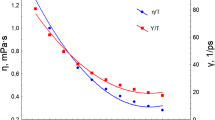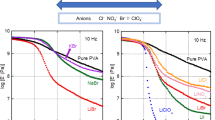Abstract
The present study focused on the effects of the addition of lithium salts such as LiI, LiBr and LiCl on the rheological properties of aqueous solutions containing 15 wt% poly(vinyl alcohol) (PVA). There was a plateau in the shear storage modulus in the low frequency region, demonstrating that such solutions have a network structure attributed to hydrogen bonding of the PVA. The value of the plateau modulus evidently decreased with temperature and with the addition of lithium salts. The experimental results also demonstrated that the anion species in the salt plays an important role in determining the rheological properties, including the magnitude of the plateau modulus. The iodide anion, which is classified as a “water-structure-breaker” ion in the Hofmeister series, effectively decreased both oscillatory shear moduli including the plateau modulus. However, the effect of adding LiI decreased at high temperatures, owing to the reduced extent of hydrogen bonding.









Similar content being viewed by others
References
Chen N, Li L, Wang Q (2007) New technology for thermal processing of poly (vinyl alcohol). Plast Rub Compos 36(7–8):283–290
Patachia S, Florea C, Friedrich CHR, Thomann Y (2009) Tailoring of poly (vinyl alcohol) cryogels properties by salts addition. Express Polym Lett 3(5):320–331
Gao H, He J, Yang R, Yang L (2010) Characteristic rheological features of high concentration PVA solutions in water with different degrees of polymerization. J Appl Polym Sci 116(5):2734–2741
Kang Y, Wang C, Qiao Y, Gu J, Zhang H, Peijs T, Shi X (2019) Tissue-engineered trachea consisting of electrospun patterned sc-PLA/GO-g-IL fibrous membranes with antibacterial property and 3D-printed skeletons with elasticity. Biomacromolecules 20(4):1765–1776
Arayachukiat S, Doan VA, Murakami T, Nobukawa S, Yamaguchi M (2015) Autonomic self-healing of poly (vinyl butyral). J Appl Polym Sci 132(22):42008
Yang X, Guo Y, Han Y, Li Y, Ma T, Chen M, Gu J (2019) Significant improvement of thermal conductivities for BNNS/PVA composite films via electrospinning followed by hot-pressing technology. Compos Part B: Eng 175:107070
Nishikawa R, Aridome N, Ojima N, Yamaguchi M (2020) Structure and properties of fiber-reinforced polypropylene prepared by direct incorporation of aqueous solution of poly (vinyl alcohol). Polymer 199:122566
Yamaura K, Naitoh M (2002) Preparation of high-performance films from poly (vinyl alcohol)/NaCl/H2O systems. J Mater Sci 37(4):705–708
Bhattacharya A, Ray P (2004) Studies on surface tension of poly (vinyl alcohol): effect of concentration, temperature, and addition of chaotropic agents. J Appl Polym Sci 93(1):122–130
Jiang X, Li H, Luo Y, Zhao Y, Hou L (2016) Studies of the plasticizing effect of different hydrophilic inorganic salts on starch/poly (vinyl alcohol) films. Int J Biol Macromol 82:223–230
Nakao H, Nagaoka T, Ogura K (1997) Ion-exchange ability of polyaniline-polyvinyl alcohol colloids with various anions. Anal Sci 13(3):327–331
Muta H, Kawauchi S, Satoh M (2003) Ion-specific swelling behavior of uncharged poly (acrylic acid) gel. Colloid Polym Sci 282(2):149–155
Song SI, Kim BC (2004) Characteristic rheological features of PVA solutions in water-containing solvents with different hydration states. Polymer 45(7):2381–2386
Mori M, Wang J, Satoh M (2009) Anti-Hofmeister series properties found for a polymer having a π electron system and acidic protons. Colloid Polym Sci 287(1):123–127
Muta H, Miwa M, Satoh M (2001) Ion-specific swelling of hydrophilic polymer gels. Polymer 42(14):6313–6316
Hosoda M, Hirano T, Sakai K (2011) Low-viscosity measurement by capillary electromagnetically spinning technique. Japan J Appl Phys 50(7S):07HB03
Li H, Zhang W, Xu W, Zhang X (2000) Hydrogen bonding governs the elastic properties of poly (vinyl alcohol) in water: single-molecule force spectroscopic studies of PVA by AFM. Macromolecules 33(2):465–469
Takigawa T, Takahashi M, Urayama K, Masuda T (1992) Comparison of model prediction with experiment for concentration-dependent modulus of poly (vinyl alcohol) (PVA) gels near the gelation point. Chem Phys Lett 195(5–6):509–512
Liu M, Cheng R, Wu C, Qian R (1997) Viscometric investigation of intramolecular hydrogen bonding cohesional entanglement in extremely dilute aqueous solution of poly vinyl alcohol. J Polym Sci B Polym Phys 35(15):2421–2427
Park JS, Park JW, Ruckenstein E (2001) On the viscoelastic properties of poly (vinyl alcohol) and chemically crosslinked poly (vinyl alcohol). J Appl Polym Sci 82(7):1816–1823
Treloar LRG (1975) The physics of rubber elasticity3rd edn. Clarendon Press, Oxford
Arayachukiat S, Siriprumpoonthum M, Nobukawa S, Yamaguchi M (2014) Viscoelastic properties and extrusion processability of poly (vinyl butyral). J Appl Polym Sci 131(11):40337
Ferry JD (1980) Viscoelastic properties of polymers3rd edn. Wiley, New York
Briscoe B, Luckham P, Zhu S (2000) The effects of hydrogen bonding upon the viscosity of aqueous poly(vinyl alcohol) solutions. Polymer 41(10):3851–3860
Saharin SM, Takahama T, Nonogaki S, Saito K, Tashiro K (2016) The effect of counter cation species on the formation of various crystal forms and their phase transition behavior of poly (vinyl alcohol)-iodine complex. Polymer 89:81–93
Sako T, Miyagawa A, Yamaguchi M (2017) Modulus enhancement of polycarbonate by addition of lithium perchlorate. J Appl Polym Sci 134(22):44882
Ito A, Maeno R, Yamaguchi M (2018) Control of optical and mechanical properties of poly(methyl methacrylate) by introducing lithium salt. Opt Mater 83:152–156
Sato Y, Ito A, Maeda S, Yamaguchi M (2018) Structure and optical properties of transparent polyamide 6 containing lithium bromide. J Polym Sci B Polym Phys 56(22):1513–1520
Tomie S, Tsugawa N, Yamaguchi M (2018) Modifying the thermal and mechanical properties of poly (lactic acid) by adding lithium trifluoromethanesulfonate. J Polym Res 25(9):206–212
Tsugawa N, Ito A, Yamaguchi M (2018) Effect of lithium salt addition on the structure and optical properties of PMMA/PVB blends. Polymer 146(20):242–248
Okazaki Y, Ishizuki K, Kawauchi S, Satoh M, Komiyama J (1996) Ion-specific swelling and deswelling behaviors of ampholytic polymer gels. Macromolecules 29(26):8391–8397
Nakano T, Yuasa H, Kanaya Y (1999) Suppression of agglomeration in fluidized bed coating. III Hofmeister series in suppression of particle agglomeration. Pharm Res 16(10):1616–1620
Wang J, Satoh M (2009) Novel PVA-based polymers showing an anti-Hofmeister series property. Polymer 50(15):3680–3685
Takano M, Ogata K, Kawauchi S, Satoh M, Komiyama J (1998) Ion-specific swelling behavior of poly (N-vinyl-2-pyrrolidone) gel: correlations with water hydrogen bond and non-freezable water. Polym Gels Net 6(3–4):217–232
Dreval VY, Tager AA, Utyumova NS (1977) Effect of inorganic salts on the viscosity of polyvinyl alcohol solutions in water and dimethylsulphoxide. Polym Sci USSR 19(7):1812–1818
Choi JH, Ko SW, Kim BC, Blackwell J, Lyoo WS (2001) Phase behavior and physical gelation of high molecular weight syndiotactic poly (vinyl alcohol) solution. Macromolecules 34(9):2964–2972
Miyagawa A, Ayerdurai V, Nobukawa S, Yamaguchi M (2016) Viscoelastic properties of poly(methyl methacrylate) with high glass transition temperature by lithium salt addition. J Polym Sci B Polym Phys 54(22):2388–2394
Ito A, Phulkerd P, Ayerdurai V, Soga M, Courtoux A, Miyagawa A, Yamaguchi M (2018) Enhancement of the glass transition temperature of poly(methyl methacrylate) by salt. Polym J 50(9):857–863
Mráček A, Varhaníková J, Lehocký M, Gřundělová L, Pokopcová A, Velebný V (2008) The influence of Hofmeister series ions on Hyaluronan swelling and viscosity. Molecules 13(5):1025–1034
Thormann E (2012) On understanding of the Hofmeister effect: how addition of salt alters the stability of temperature responsive polymers in aqueous solutions. RSC Adv 2(22):8297–8305
Acknowledgements
This study was supported by COI program of JST, “Construction of next-generation infrastructure system using innovative materials.” Realization of safe and secure society that can coexist with the earth for centuries. The authors appreciate Mr. Naoya Tsugawa of Tosoh Analysis and Research Center Co., Ltd. for his technical support of the EMS viscometer measurements.
Author information
Authors and Affiliations
Corresponding author
Additional information
Publisher’s note
Springer Nature remains neutral with regard to jurisdictional claims in published maps and institutional affiliations.
Rights and permissions
About this article
Cite this article
Saari, R.A., Maeno, R., Tsuyuguchi, R. et al. Impact of Lithium halides on rheological properties of aqueous solution of poly(vinyl alcohol). J Polym Res 27, 218 (2020). https://doi.org/10.1007/s10965-020-02198-y
Received:
Accepted:
Published:
DOI: https://doi.org/10.1007/s10965-020-02198-y




